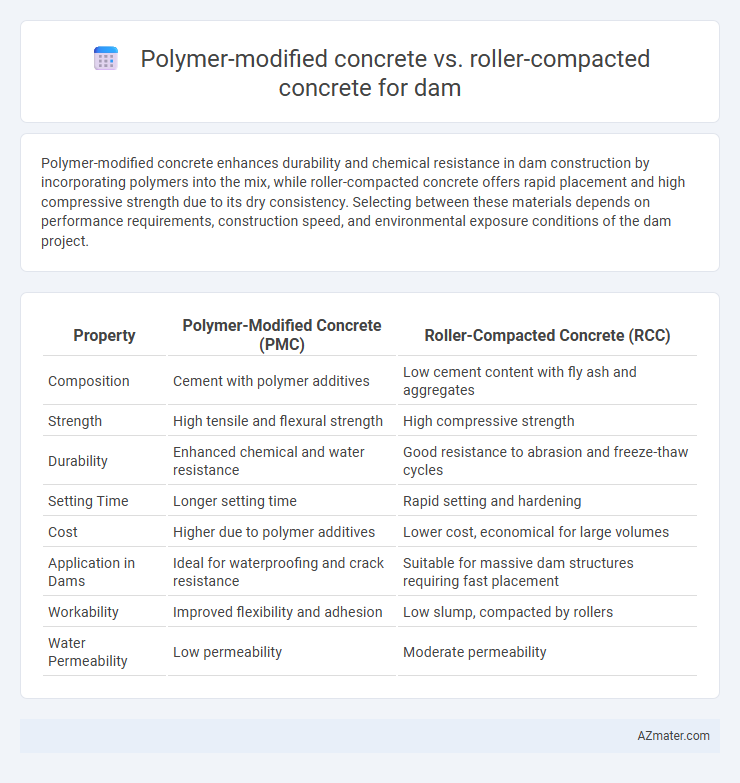Polymer-modified concrete enhances durability and chemical resistance in dam construction by incorporating polymers into the mix, while roller-compacted concrete offers rapid placement and high compressive strength due to its dry consistency. Selecting between these materials depends on performance requirements, construction speed, and environmental exposure conditions of the dam project.
Table of Comparison
| Property | Polymer-Modified Concrete (PMC) | Roller-Compacted Concrete (RCC) |
|---|---|---|
| Composition | Cement with polymer additives | Low cement content with fly ash and aggregates |
| Strength | High tensile and flexural strength | High compressive strength |
| Durability | Enhanced chemical and water resistance | Good resistance to abrasion and freeze-thaw cycles |
| Setting Time | Longer setting time | Rapid setting and hardening |
| Cost | Higher due to polymer additives | Lower cost, economical for large volumes |
| Application in Dams | Ideal for waterproofing and crack resistance | Suitable for massive dam structures requiring fast placement |
| Workability | Improved flexibility and adhesion | Low slump, compacted by rollers |
| Water Permeability | Low permeability | Moderate permeability |
Introduction to Concrete Types in Dam Construction
Polymer-modified concrete enhances durability and chemical resistance by integrating polymers into traditional concrete, making it ideal for dam sections exposed to aggressive environments. Roller-compacted concrete (RCC) offers rapid placement and high compressive strength through a dry mixture compacted by rollers, commonly used in large-scale dam construction for its cost-effectiveness and structural efficiency. Selecting between polymer-modified concrete and RCC depends on specific dam requirements such as exposure conditions, construction speed, and long-term performance criteria.
Overview of Polymer-Modified Concrete
Polymer-modified concrete (PMC) incorporates synthetic polymers to enhance the material's adhesion, flexibility, and chemical resistance, making it highly suitable for dam structures subjected to fluctuating stress and environmental conditions. Its improved tensile strength and reduced permeability provide superior durability against water ingress and chemical attack compared to traditional concrete formulations. PMC's adaptability in mixing and curing processes allows for tailored performance characteristics vital in dam construction and repair applications.
Understanding Roller-Compacted Concrete
Roller-compacted concrete (RCC) is a high-density, low-slump concrete widely used in dam construction due to its rapid placement and reduced construction costs compared to conventional concrete types. RCC utilizes a drier mix that allows for compaction with vibratory rollers, providing enhanced strength, durability, and resistance to thermal cracking, which are critical for dam integrity. Unlike polymer-modified concrete, which incorporates polymers to improve bonding and flexibility, RCC prioritizes volumetric stability and efficient mass placement, making it ideal for large-scale dam applications.
Material Composition Comparison
Polymer-modified concrete (PMC) incorporates polymers such as styrene-butadiene or acrylics into the concrete mix, enhancing adhesion, flexibility, and resistance to chemical attacks and water infiltration. Roller-compacted concrete (RCC) consists of a drier mix with lower cement content and minimal water, using coarse aggregates compacted with heavy rollers, optimizing strength and rapid construction for dam applications. The contrasting material compositions result in PMC offering superior durability and impermeability, while RCC provides cost-effective, fast placement with significant structural strength.
Strength and Durability Factors
Polymer-modified concrete exhibits enhanced tensile strength and improved resistance to cracking, making it highly suitable for dam structures subjected to dynamic loads and environmental stress. Roller-compacted concrete offers superior compressive strength and rapid construction advantages, but may require additional admixtures to improve durability against freeze-thaw cycles and chemical attack. Both materials provide distinct benefits, with polymer-modified concrete excelling in flexibility and durability, while roller-compacted concrete offers cost efficiency and robustness in compressive strength.
Water Resistance and Permeability
Polymer-modified concrete exhibits superior water resistance and significantly lower permeability compared to roller-compacted concrete, making it highly effective in dam applications where water tightness is crucial. The incorporation of polymers enhances the concrete matrix by reducing pore connectivity, thereby limiting water ingress and improving durability under hydrostatic pressure. Roller-compacted concrete, while beneficial for rapid placement and large-volume dams, typically requires additional treatments or admixtures to achieve comparable impermeability and minimize seepage risks.
Construction Methods and Ease of Application
Polymer-modified concrete (PMC) offers enhanced bonding and flexibility, allowing precise application methods such as spraying or troweling suitable for complex dam shapes. Roller-compacted concrete (RCC) utilizes a dry mix compacted by heavy rollers, enabling rapid placement with minimal formwork, ideal for large-scale dam construction. PMC requires careful curing to optimize polymer performance, while RCC emphasizes efficient layering and compaction for structural integrity and speed.
Cost Analysis and Economic Considerations
Polymer-modified concrete (PMC) typically incurs higher initial material costs due to the addition of polymers enhancing durability and chemical resistance, which reduces long-term maintenance expenses for dam construction. Roller-compacted concrete (RCC) offers significant cost savings through faster placement rates, reduced labor requirements, and lower cement content, making it economically favorable for large-scale dam projects. The choice between PMC and RCC depends on balancing upfront investment against lifecycle costs, with RCC favored for budget efficiency and PMC selected when enhanced performance justifies the premium.
Suitability for Different Dam Structures
Polymer-modified concrete offers enhanced durability, chemical resistance, and improved bonding, making it highly suitable for spillways and thin sections in dams requiring high impermeability and flexibility. Roller-compacted concrete, valued for its rapid placement and cost-effectiveness, is ideal for large-scale gravity dams and embankment dams where mass and strength are prioritized over intricate detailing. The choice depends on specific dam structure requirements, with polymer-modified concrete favored for complex, high-stress areas and roller-compacted concrete preferred for massive, straightforward dam bodies.
Environmental Impact and Sustainability
Polymer-modified concrete offers enhanced durability and reduced permeability, which minimizes water seepage and extends dam lifespan, thereby reducing environmental degradation. Roller-compacted concrete (RCC) uses less cement and water, lowering carbon emissions and promoting resource efficiency in dam construction. Both materials contribute to sustainability by improving structural resilience, but RCC generally has a smaller carbon footprint due to its mix design and faster placement, making it a more eco-friendly choice for large-scale dam projects.

Infographic: Polymer-modified concrete vs Roller-compacted concrete for Dam
 azmater.com
azmater.com